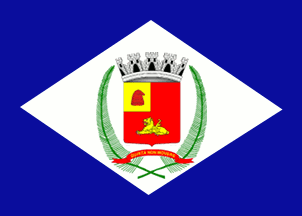 image by Dirk Schönberger,
19 January 2013
image by Dirk Schönberger,
19 January 2013Based on: http://www.rioclaro.sp.gov.br/municipio/municipio_simbolos.php

Last modified: 2013-02-02 by ian macdonald
Keywords: sao paulo | rio claro |
Links: FOTW homepage |
search |
disclaimer and copyright |
write us |
mirrors
 image by Dirk Schönberger,
19 January 2013
image by Dirk Schönberger,
19 January 2013
Based on:
http://www.rioclaro.sp.gov.br/municipio/municipio_simbolos.php
A blue flag with a white lozenge bearing the municipal arms.
Official website at
http://www.rioclaro.sp.gov.br
Dirk Schönberger,
19 January 2013
Rio Claro was founded in 1822, under the name of São João Batista do Ribeirão Claro, around a chapel dedicated to St. John the Baptist, erected by Captain Francisco da Costa Alves. The district of São João Batista do Ribeirão Claro, part of the municipality of Piracicaba, was established by Imperial Decree of 9 December 1830, and transferred to the municipality of Limeira by Law No. 25 of 8 March 1842. The municipality of São João do Rio Claro was established by Provincial Law No. 13 of 7 March 1845, seceding from Limeira and Mogi Mirim, and renamed Rio Claro by State Law No. 975 of 20 December 1905.
The flag of Rio Claro is blue with a white lozenge charged with the municipal coat of arms.
The flag is in dimensions 14 units x 20 units. The blue field reflects the sensibility of the inhabitants, as emphasized by the poet Arthur Bilac, who proclaimed Rio Claro "Blue town of accomplished dreams where our ancestors planted seeds that fructified in us". The white lozenge represents the atmosphere of peace favoured by the inhabitants. By its shape, the lozenge symbolizes the integration of Rio Claro in the national harmony. The coat of arms represents the presence of our ancestors, respect for their value, and respect of tradition.
Photos of the flag
http://g1.globo.com/sp/sao-carlos-regiao/noticia/2012/06/aniversario-de-rio-claro-tem-fafa-de-belem-e-filarmonica-neste-domingo.html
http://sourioclarofc.blogspot.fr/2011/12/rio-claro-fc-apresenta-parceria-e.html
The coat of arms of Rio Claro, designed by Dr. Zulmiro Ferraz de Campos and Carlos Hadler, is prescribed by a Municipal Law adopted on 24 February 1932. "A shield surmounted by a mural crown argent and supported by two palms of indaiá*, gules a lion dormant or a canton or charged with a liberty cap gules. Below the shield a scroll gules inscribed with the motto 'QUIETA NON MOVERE' in letters or."
The five-towered mural crown represents a noble and loyal town. The palms of indaiá* represent a palm tree commonly found in Rio Claro, which was originally named "Indaiá Land". Gules is the symbol of the victories and conquests achieved by the inhabitants and of their patriotic feeling. The resting lion is the symbol of the inhabitants resting after the political victories and the obtained liberty. The liberty cap represents the Republic and Liberty. It is placed in chief, the honour point of the shield, to show that Rio Claro has always been a stronghold for the liberal and republican ideals. Or is a symbol of nobleness, strong-mindedness, power, richness and knowledge. The motto means "Don't bug those who rest" or "Warning, leave these people in peace".
On the flag, the scroll below the shield seems to be omitted.
* indaiá [Attalea dubia (Mart.) Burret; synonym, Attalea indaya_
Drude] is a Brazilian palm best known as the Bacuaçu palm.
http://commons.wikimedia.org/wiki/File:Palmeira_de_indaiá_REFON_.jpg - Photo
http://coldb.mnhn.fr/ScientificName/attalea/dubia - Herbarium
specimens at the National Museum of Natural History, Paris
Ivan Sache, 20 January 2013